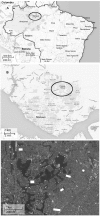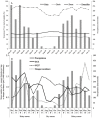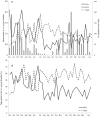Temporal abundance of Aedes aegypti in Manaus, Brazil, measured by two trap types for adult mosquitoes
- PMID: 25494470
- PMCID: PMC4325619
- DOI: 10.1590/0074-0276140234
Temporal abundance of Aedes aegypti in Manaus, Brazil, measured by two trap types for adult mosquitoes
Abstract
A longitudinal study was conducted in Manaus, Brazil, to monitor changes of adult Aedes aegypti (L.) abundance. The objectives were to compare mosquito collections of two trap types, to characterise temporal changes of the mosquito population, to investigate the influence of meteorological variables on mosquito collections and to analyse the association between mosquito collections and dengue incidence. Mosquito monitoring was performed fortnightly using MosquiTRAPs (MQT) and BG-Sentinel (BGS) traps between December 2008-June 2010. The two traps revealed opposing temporal infestation patterns, with highest mosquito collections of MQTs during the dry season and highest collections of BGS during the rainy seasons. Several meteorological variables were significant predictors of mosquito collections in the BGS. The best predictor was the relative humidity, lagged two weeks (in a positive relationship). For MQT, only the number of rainy days in the previous week was significant (in a negative relationship). The correlation between monthly dengue incidence and mosquito abundance in BGS and MQT was moderately positive and negative, respectively. Catches of BGS traps reflected better the dynamic of dengue incidence. The findings help to understand the effects of meteorological variables on mosquito infestation indices of two different traps for adult dengue vectors in Manaus.
Figures



Similar articles
-
Meteorological variables and mosquito monitoring are good predictors for infestation trends of Aedes aegypti, the vector of dengue, chikungunya and Zika.Parasit Vectors. 2017 Feb 13;10(1):78. doi: 10.1186/s13071-017-2025-8. Parasit Vectors. 2017. PMID: 28193291 Free PMC article.
-
Mass trapping with MosquiTRAPs does not reduce Aedes aegypti abundance.Mem Inst Oswaldo Cruz. 2015 Jun;110(4):517-27. doi: 10.1590/0074-02760140374. Epub 2015 Apr 28. Mem Inst Oswaldo Cruz. 2015. PMID: 25946154 Free PMC article. Clinical Trial.
-
Evaluation of the effectiveness of mass trapping with BG-sentinel traps for dengue vector control: a cluster randomized controlled trial in Manaus, Brazil.J Med Entomol. 2014 Mar;51(2):408-20. doi: 10.1603/me13107. J Med Entomol. 2014. PMID: 24724291
-
Surveillance of Aedes aegypti: comparison of house index with four alternative traps.PLoS Negl Trop Dis. 2015 Feb 10;9(2):e0003475. doi: 10.1371/journal.pntd.0003475. eCollection 2015 Feb. PLoS Negl Trop Dis. 2015. PMID: 25668559 Free PMC article.
-
BG-Sentinel™ Trap Efficacy As A Component of Proof-Of-Concept For Push-Pull Control Strategy For Dengue Vector Mosquitoes.J Am Mosq Control Assoc. 2017 Dec;33(4):293-300. doi: 10.2987/16-6552.1. J Am Mosq Control Assoc. 2017. PMID: 29369029
Cited by
-
The first detected airline introductions of yellow fever mosquitoes (Aedes aegypti) to Europe, at Schiphol International airport, the Netherlands.Parasit Vectors. 2017 Dec 8;10(1):603. doi: 10.1186/s13071-017-2555-0. Parasit Vectors. 2017. PMID: 29221490 Free PMC article.
-
Evaluation of CDC light traps for mosquito surveillance in a malaria endemic area on the Thai-Myanmar border.Parasit Vectors. 2015 Dec 15;8:636. doi: 10.1186/s13071-015-1225-3. Parasit Vectors. 2015. PMID: 26666683 Free PMC article.
-
Increased Adult Aedes aegypti and Culex quinquefasciatus (Diptera: Culicidae) Abundance in a Dengue Transmission Hotspot, Compared to a Coldspot, within Kaohsiung City, Taiwan.Insects. 2018 Aug 13;9(3):98. doi: 10.3390/insects9030098. Insects. 2018. PMID: 30104501 Free PMC article.
-
Assessment of a trap based Aedes aegypti surveillance program using mathematical modeling.PLoS One. 2018 Jan 5;13(1):e0190673. doi: 10.1371/journal.pone.0190673. eCollection 2018. PLoS One. 2018. PMID: 29304070 Free PMC article.
-
[Recommendations for the surveillance of Aedes aegypti].Biomedica. 2016 Sep 1;36(3):454-462. doi: 10.7705/biomedica.v36i3.2892. Biomedica. 2016. PMID: 27869394 Free PMC article. Review.
References
-
- Azil AH, Long SA, Ritchie SA, Williams CR. The development of predictive tools for pre-emptive dengue vector control: a study of Aedes aegypti abundance and meteorological variables in North Queensland, Australia. Trop Med Int Health. 2010;15:1190–1197. - PubMed
-
- Ball TS, Ritchie SR. Sampling biases of the BG-Sentinel trap with respect to physiology, age and body size of adult Aedes aegypti (Diptera: Culicidae) J Med Entomol. 2010;4(7):649–656. - PubMed
-
- Bastos MS, Figueiredo RM, Ramasawmy R, Itapirema E, Gimaque JB, Santos LO, Figueiredo LT, Mourão MP. Simultaneous circulation of all four dengue serotypes in Manaus, state of Amazonas, Brazil in 2011. Rev Soc Bras Med Trop. 2012;45:393–394. - PubMed
-
- Beserra EB, Castro FPJ, dos Santos JW, Santos TS, Fernandes CR. Biologia e exigências térmicas de Aedes aegypti (L.) (Diptera: Culicidae) provenientes de quatro regiões bioclimáticas da Paraíba. Neotrop Entomol. 2006;35:853–860. - PubMed
Publication types
MeSH terms
LinkOut - more resources
Full Text Sources
Other Literature Sources
Medical

